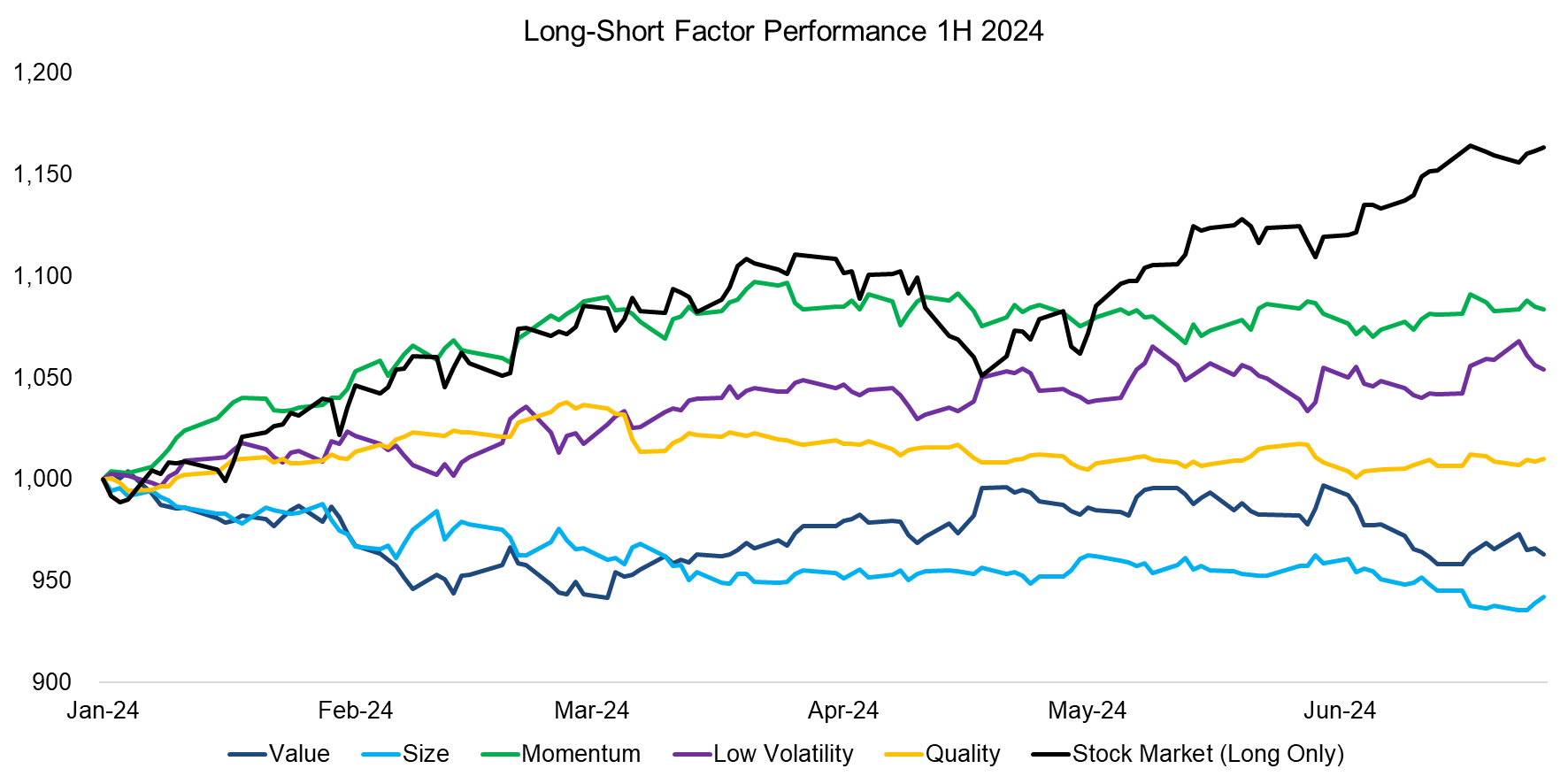Factor Olympics 1H 2024
And the winner is…
July 2024. Reading Time: 10 Minutes. Author: Nicolas Rabener.
SUMMARY
- The losers of last year, ie momentum and low volatility, became the winners of this year
- Momentum performed the best, size the worst
- Long-short multi-factor products have generated positive excess returns
INTRODUCTION
We present the performance of five well-known factors on an annual basis for the last 10 years. Specifically, we only present factors where academic research supports the existence of positive excess returns across market cycles and asset classes.
METHODOLOGY
Our factors are created by constructing long-short beta-neutral portfolios of the top and bottom 30% of stocks. Only stocks with a minimum market capitalization of $1 billion are included. Portfolios rebalance monthly and transactions incur 10 basis points of costs.
FACTOR OLYMPICS: GLOBAL EXCESS RETURNS
The table below shows the long-short factor performance for the last 10 years ranked top to bottom. The global series is comprised of all developed markets in Asia, Europe, and the US. Aside from displaying the factor performance, the analysis highlights the significant factor rotation in terms of profitability from one year to the next, highlighting the benefits of diversified exposure.
We observe a continuation of last year’s trends in factor performance for the value and size factors, but also a significant rotation of momentum and low volatility going from the worst- to the best-performing factors in the first half of 2024.
Over the last decade, the quality and low volatility factors exhibited the highest performance consistency with positive returns in eight out of ten years, while the size factor generated negative returns in nine out of ten years. Having said this, these relationships do not hold over the long-term and factor rotation is rather the norm than the exception.
A theoretical portfolio providing equal-weighted exposure to all five factors would have generated 1.0% year-to-date.

Source: Finominal
TRENDS IN GLOBAL FACTOR PERFORMANCE
The first quarter of 2024 showed divergent trends in factor performance, while in the second quarter, these trends flat-lined with the quarter changes ranging from -1.4% for the value to 0.5% for the low volatility factor.

Source: Finominal
PERFORMANCE OF LONG-SHORT MULTI-FACTOR PRODUCTS
There are only a few liquid alternative mutual funds and ETFs that provide pure exposure to factors in the long-short format as seen in academic research. The last decade has seen many fund liquidations, however, Simplify Asset Management launched two new products in 2023, namely the Simplify Market Neutral Equity Long/Short ETF (EQLS) and Simplify Multi-QIS Alternative ETF (QIS), which provide exposure to equity and cross-asset factors.
We observe that all six products generated positive excess returns in the first half of 2024. However, there is a large dichotomy in returns with the two products from AQR, namely the AQR Equity Market Neutral Fund (QMNIX) and AQR Style Premia Alternative Fund (QSPRX), generating significantly higher and more consistent returns than the other four products.

Source: Finominal
SMART BETA EXCESS RETURNS
Although investors should allocate to factors constructed as long-short portfolios given that these offer high diversification benefits, most invest via long-only smart beta ETFs (read Smart Beta vs Alpha + Beta). Following the money, we highlight the excess returns generated from investing in smart beta ETFs in the US, which represents a universe of 160+ products and approximately $800 billion of assets under management. We also show the performance of the growth factor, which is popular with investors but is not associated with positive excess returns over time (read What Are Growth Stocks?).
We observe the same trends in smart beta excess returns and theoretical long-short factor returns for the value, size, and momentum factors, while we see a divergence for the quality and low volatility factors. The significant divergence in the returns of the low volatility factor can be explained by the differences between long-short and long-only portfolio construction, namely shorting high volatility stocks, achieving beta-neutrality via leverage, and equal versus market cap-weighting. Investors should be aware that long-only smart beta products can not offer the same excess returns seen in academic research.

Source: Finominal
FACTOR CORRELATIONS
In the first quarter of 2024, the 12-month correlations between factors were not particularly extreme in either direction, but this had changed with value and momentum as well as size and low volatility becoming more negatively correlated, while momentum and quality became more positively correlated. Naturally this makes diversification with a multi-factor approach more challenging as too negative correlations will lead to excess returns cancel each other out.

Source: Finominal
FURTHER THOUGHTS
If there is one take-away from this research update, then it should be that factors are cyclical as that is the prevalent theme of the first half of 2024. The obvious choice to mitigate this is to diversify across factors by allocating to multi-factor products. However, although that is sensible via long-short multi-factor products like QMNIX, most long-only multi-factor products are poorly constructed by offering too low factor exposures (read Multi-Factor Smart Beta ETFs). If you believe in factor investing, then best to do it properly.
RELATED RESEARCH
The Illusion of the Small-Cap Premium
Shorting Lousy Stocks = Lousy Returns?
Higher Volatility, Higher Alpha?
Outperformance Ain’t Alpha
Improving the Odds of Value Investing
The Value Factor’s Pain: Are Intangibles to Blame?
Smart Beta vs Alpha + Beta
How Painful Can Factor Investing Get?
GARP Investing: Golden or Garbage? II
ABOUT THE AUTHOR
Nicolas Rabener is the CEO & Founder of Finominal, which empowers professional investors with data, technology, and research insights to improve their investment outcomes. Previously he created Jackdaw Capital, an award-winning quantitative hedge fund. Before that Nicolas worked at GIC and Citigroup in London and New York. Nicolas holds a Master of Finance from HHL Leipzig Graduate School of Management, is a CAIA charter holder, and enjoys endurance sports (Ironman & 100km Ultramarathon).
Connect with me on LinkedIn or X.

